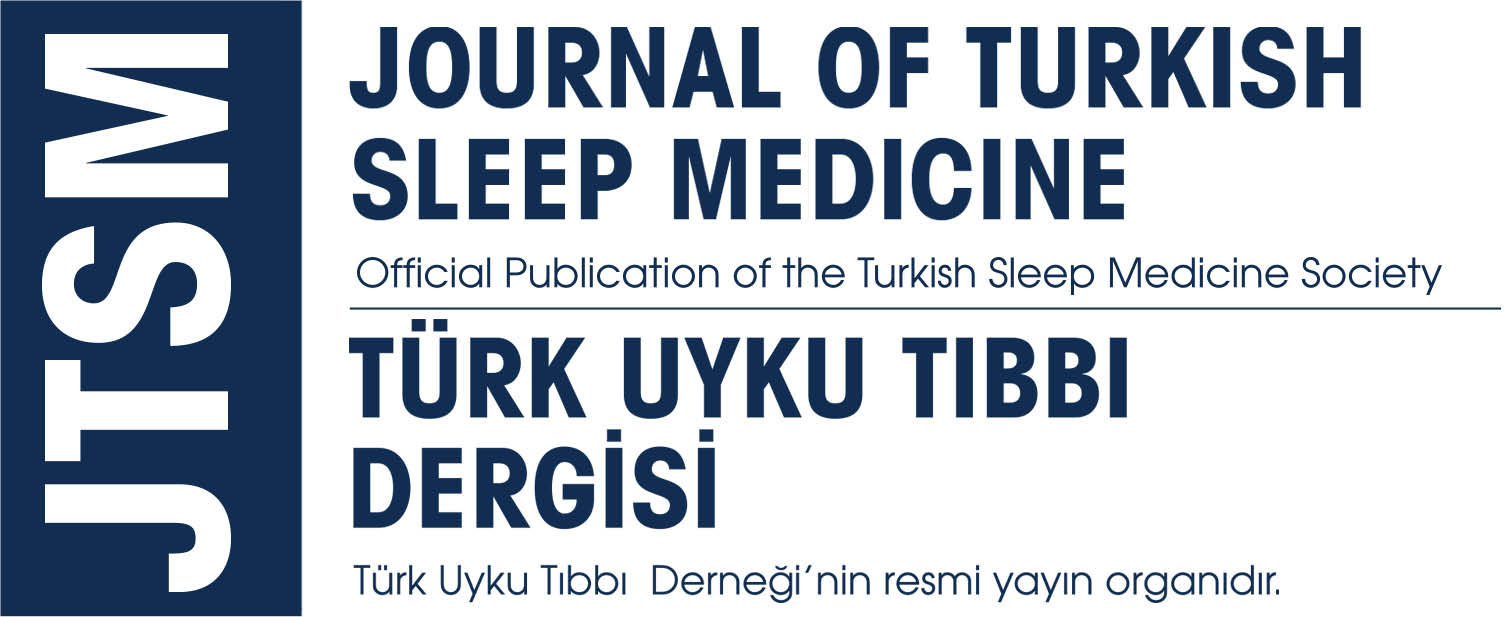ABSTRACT
Conclusion:
In this study, sleep-related hypoventilation was not detected in any patient with asthma and in controls, while one patient with COPD was diagnosed with sleep-related hypoventilation upon routine carbon dioxide monitoring. Defining some criteria using additional correlations with respiratory parameters would help monitor carbon dioxide level in a selected subgroup of patients with COPD.
Results:
The study group included 36 individuals with asthma and 27 individuals with chronic obstructive pulmonary disease (COPD), whereas the control group included 52 individuals without any pulmonary diseases. The three groups were comparable in terms of age, gender and body mass index. Obstructive sleep apnoea syndrome was most commonly observed in patients in the COPD group (p=0.003). However, no difference was observed between patients in the asthma and control groups. Partial carbon dioxide pressure during wakefulness, non-rapid eye movement and rapid eye movement sleep were not significantly different among the three groups. In the control group, no patient had sleep-related hypoxemia and/or hypoventilation. Two patients with asthma (5.5%) and one patient with COPD (3.7%) had sleep-related hypoxemia, while one patient with COPD had sleep-related hypoventilation (3.7%).
Materials and Methods:
This retrospective cohort study enrolled adult patients with pulmonary disease and a control group who had PSG recordings and carbon dioxide monitoring for the last 3 years.
Objective:
Polysomnography (PSG) is a standard test used in the diagnosis of sleep-related breathing disorders. However, carbon dioxide monitoring is not routinely implemented in adults. This study aimed to investigate the necessity of full-night carbon dioxide monitoring during PSG in patients with pulmonary disease.
Keywords:
Asthma, chronic obstructive pulmonary disease, obstructive sleep apnoea syndrome, polysomnography, carbon dioxide monitoring
References
1Kushida CA, Littner MR, Morgenthaler T, Alessi CA, Bailey D, Coleman J Jr, Friedman L, Hirshkowitz M, Kapen S, Kramer M, Lee-Chiong T, Loube DL, Owens J, Pancer JP, Wise M. Practice parameters for the indications for polysomnography and related procedures: an update for 2005. Sleep 2005;28:499-521.
2American Academy of Sleep Medicine. The AASM Manual for the Scoring of Sleep and Associated Events: Rules, Terminology and Technical Specifications. Version 2.6.: American Academy of Sleep Medicine, Darien, IL, 2020.
3Vaidya S, Gothi D, Patro M. Prevalence of sleep disorders in chronic obstructive pulmonary disease and utility of global sleep assessment questionnaire: an observational case-control study. Ann Thorac Med 2020;15:230-7.
4D’Cruz RF, Murphy PB, Kaltsakas G. Sleep disordered breathing and chronic obstructive pulmonary disease: a narrative review on classification, pathophysiology and clinical outcomes. J Thorac Dis 2020;12:S202-16.
5Bahammam RA, Al-Qahtani KM, Aleissi SA, Olaish AH, Almeneessier AS, Bahammam AS. The associations of gender, menopause, age, and asthma with rem-predominant obstructive sleep apnea: a prospective observational study. Nat Sci Sleep 2020;12:721-35.
6Saraç S, Afşar GÇ. Obstrüktif uyku apne sendromu, kronik obstrüktif akciğer hastalığı ve astım birlikteliği. J Turk Sleep Med 2017;4:43-7.
7Mishima M. Physiological differences and similarities in asthma and COPD--based on respiratory function testing. Allergol Int 2009;58:333-40.
8American Academy of Sleep Medicine. International classification of sleep disorders, 3rd ed. American Academy of Sleep Medicine, Darien, IL, 2014.
9Boentert M, Glatz C, Helmle C, Okegwo A,Young P. Prevalence of sleep apnoea and capnographic detection of nocturnal hypoventilation in amyotrophic lateral sclerosis. J Neurol Neurosurg Psychiatry 2018;89:418-24.
10Reyhani A, Benbir Senel G, Karadeniz D. Effects of sleep-related disorders on the prognosis of amyotrophic lateral sclerosis. Neurodegener Dis 2019;19:148-54.
11Burman D. Sleep Disorders: Sleep-Related Breathing Disorders. FP Essent 2017;460:11-21.
12Güneş A, Yıldız D, Dikiş ÖŞ, Durmaz D, Dülger S, Pekel NB, Seferoğlu M. Astım hastalarında huzursuz bacaklar sendromu birlikteliği ve uyku kalitesi. J Turk Sleep Med 2019;6:7-9.
13Jen R, Li Y, Owens RL, Malhotra A. Sleep in chronic obstructive pulmonary disease: Evidence gaps and challenges. Can Respir J 2016;2016:7947198.
14Kreiger AC, Patel N, Green D, Modersitzki F, Belitskaya -Levy I, Lorenzo A, Cutaia M. Respiratory distrubance during sleep in COPD patients without daytime hypoxemia. Int J Crohn Obstruct Pulmon Dis 2007;2:609-15.
15Ramos-Ramírez P, Malmhäll C, Johansson K, Adner M, Lötvall J, Bossios A. lung regulatory t cells express adiponectin receptor 1: modulation by obesity and airway allergic ınflammation. Int J Mol Sci 2020;21:8990.
16Benbir Şenel G, Ağan K, Sünter G, Aktaç Ş, Karadeniz D, Koşunda A, Aydın G, Güneş FE. Obstrüktif uyku apne sendromu ile diyabet ilişkisinin antropometrik ölçümlere göre incelenmesi. J Turk Sleep Med 2020;7:11-6.



